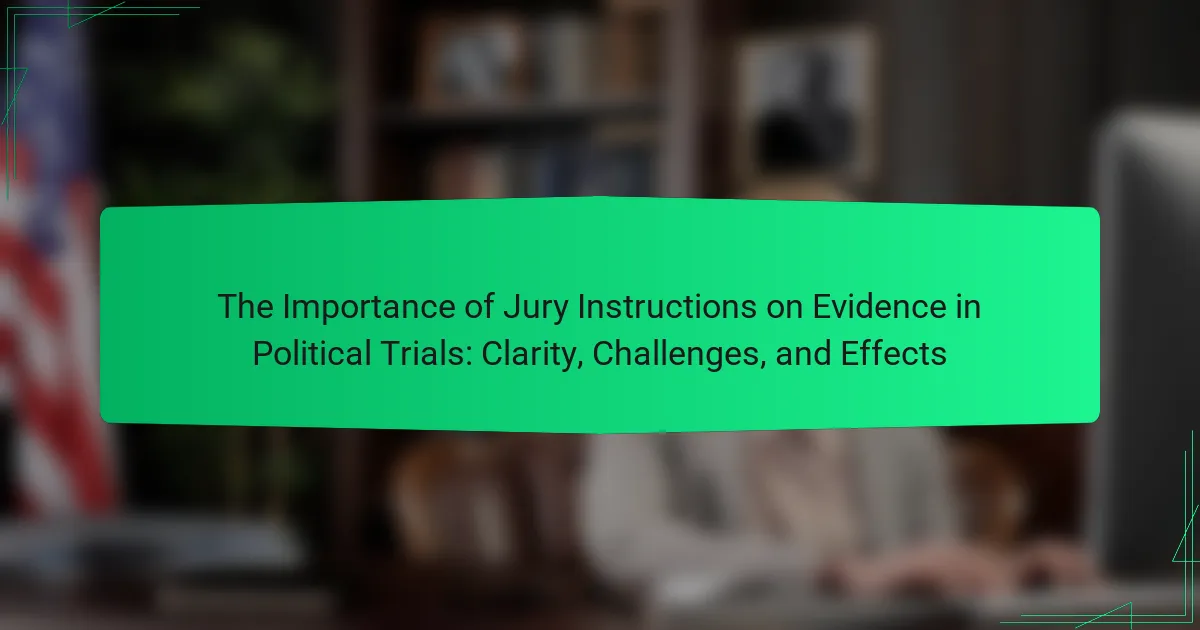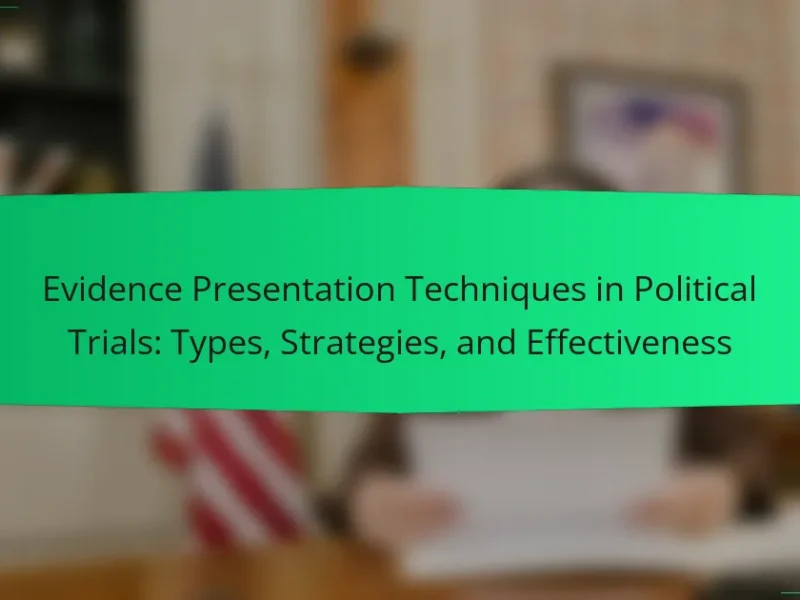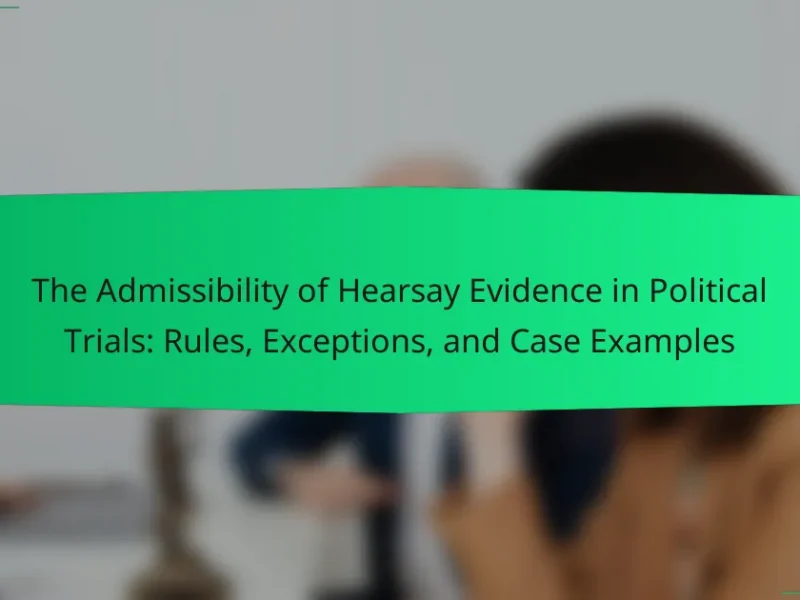Jury instructions on evidence in political trials serve as essential guidelines for jurors, clarifying how to evaluate various types of evidence such as witness testimony, documents, and physical evidence. These instructions establish the legal standards that jurors must apply, including the burden of proof and the presumption of innocence for defendants. However, challenges arise due to the complexity and ambiguity of legal language, which can lead to misinterpretation and affect the fairness of trial outcomes. Research highlights that clear and concise jury instructions significantly enhance juror comprehension, ultimately influencing verdicts in political trials. The article explores the importance of effective jury instructions, the challenges they present, and their impact on trial fairness.
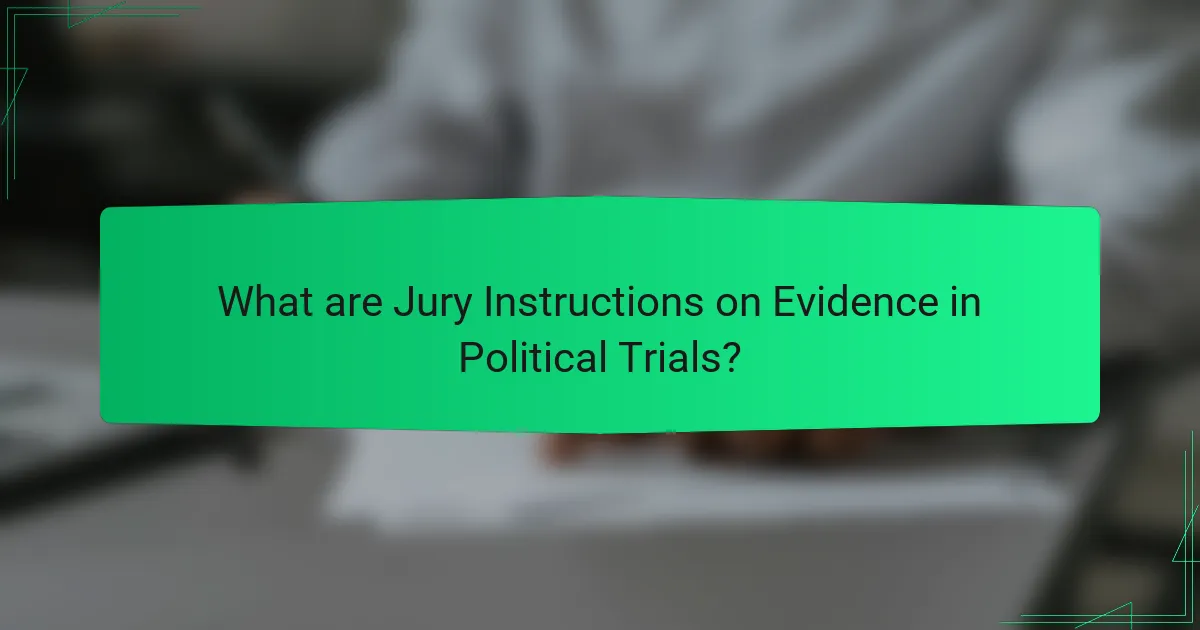
What are Jury Instructions on Evidence in Political Trials?
Jury instructions on evidence in political trials are guidelines provided to jurors. These instructions clarify how to evaluate evidence presented during the trial. They inform jurors about the legal standards that must be applied. The instructions also outline the types of evidence that are admissible. This includes witness testimony, documents, and physical evidence. Additionally, jury instructions help jurors understand the burden of proof. They explain the presumption of innocence for defendants. Clear jury instructions are essential for fair deliberation. They ensure that jurors make decisions based on the law and facts presented.
How do Jury Instructions impact the trial process?
Jury instructions significantly impact the trial process by guiding jurors on how to interpret the law and evidence. These instructions shape jurors’ understanding of their roles and responsibilities. Clear jury instructions can enhance jurors’ ability to make informed decisions based on the evidence presented. Conversely, ambiguous or complex instructions may lead to confusion and misinterpretation of the law. Research indicates that jurors often rely heavily on these instructions when deliberating. Studies show that well-structured jury instructions can improve the accuracy of verdicts. For instance, the American Bar Association emphasizes the importance of clarity in jury instructions to ensure fair trials. Therefore, jury instructions play a crucial role in the effectiveness and fairness of the trial process.
What key elements are included in Jury Instructions?
Key elements included in Jury Instructions are definitions of legal terms, explanations of the burden of proof, and guidelines for evaluating evidence. They also outline the applicable law and the roles of jurors. Jury Instructions clarify the standards that jurors must use when deliberating. They ensure that jurors understand the legal framework surrounding the case. Clear instructions help prevent misunderstandings during the trial process. Accurate Jury Instructions are crucial for fair verdicts. They are often tailored to the specifics of each case.
How do these elements guide jurors in their decision-making?
Elements such as clarity, relevance, and comprehensiveness in jury instructions guide jurors in their decision-making. Clear instructions help jurors understand the legal standards they must apply. Relevant information ensures jurors focus on the most pertinent evidence presented during the trial. Comprehensive instructions provide jurors with the necessary context to evaluate evidence accurately. Research shows that jurors who receive well-structured instructions are more likely to reach fair and informed verdicts. Studies indicate that clarity in jury instructions can significantly reduce confusion and enhance jurors’ ability to deliberate effectively.
Why is Clarity in Jury Instructions Crucial?
Clarity in jury instructions is crucial because it ensures jurors understand their roles and the legal standards they must apply. Clear instructions reduce the risk of misinterpretation. Misunderstandings can lead to incorrect verdicts. Studies show that jurors often struggle with complex legal language. For example, a study by the National Center for State Courts found that jurors frequently misinterpret vague instructions. This misinterpretation can undermine the fairness of the trial. Therefore, clear and straightforward jury instructions enhance the integrity of the judicial process.
What are the potential consequences of unclear Jury Instructions?
Unclear jury instructions can lead to significant consequences in legal proceedings. They may result in jurors misunderstanding the law or the evidence presented. This misunderstanding can cause jurors to make decisions based on incorrect legal standards. Consequently, verdicts may be inconsistent with the law. In some cases, unclear instructions can lead to appeals and retrials. A study by the National Center for State Courts found that unclear jury instructions are a common reason for mistrials. This highlights the importance of clarity in jury instructions to ensure fair trials.
How does clarity affect juror comprehension and outcomes?
Clarity significantly enhances juror comprehension and outcomes. Clear jury instructions lead to better understanding of legal standards. When jurors grasp the information presented, they make more informed decisions. Research shows that jurors exposed to clear instructions are more likely to align their verdicts with the evidence. A study by the National Center for State Courts found that jurors who received simplified instructions demonstrated improved comprehension. This improved understanding directly correlates with more accurate verdicts. Therefore, clarity in jury instructions is essential for fair trial outcomes.
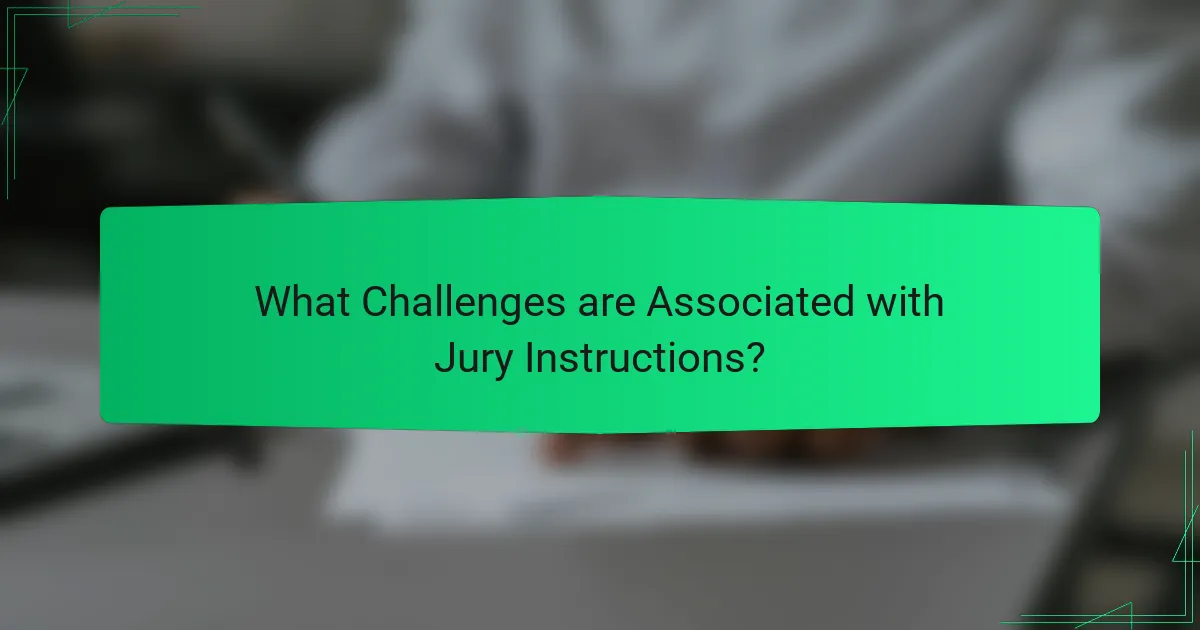
What Challenges are Associated with Jury Instructions?
Challenges associated with jury instructions include complexity and ambiguity. Jurors often struggle to understand legal jargon. This can lead to misinterpretation of the instructions. Ambiguous language in instructions can cause confusion. Jurors may apply their own biases when interpreting unclear instructions. Additionally, instructions may not adequately address specific case facts. This can result in a disconnect between the law and jurors’ understanding. Research indicates that clear, concise instructions improve juror comprehension. However, many courts still use outdated or convoluted language. These challenges ultimately affect the fairness of trials.
What common issues arise in the drafting of Jury Instructions?
Common issues in drafting jury instructions include ambiguity, complexity, and inconsistency. Ambiguity occurs when language is unclear, leading to different interpretations. Complexity arises from legal jargon that jurors may not understand. Inconsistency happens when instructions contradict each other, confusing jurors. These issues can affect juror comprehension and decision-making. Clear and straightforward language is essential for effective instructions. Studies show that well-drafted instructions improve juror understanding and case outcomes.
How do these issues vary across different political trials?
Issues in political trials vary significantly based on the context of each case. Different political trials can involve unique legal standards and evidentiary rules. For instance, trials involving government officials may face stricter scrutiny regarding the admissibility of evidence. In contrast, trials related to political activism might emphasize First Amendment rights more heavily. The public’s perception can also influence these trials, affecting jury dynamics and instructions. Historical context plays a role, as past political trials may set precedents impacting current cases. The involvement of media can vary, impacting juror exposure to information. Additionally, the political climate can shape the interpretation of evidence and jury instructions. Overall, these factors contribute to the variability of issues across political trials.
What role do judges play in addressing these challenges?
Judges play a critical role in addressing challenges related to jury instructions in political trials. They ensure that jury instructions are clear and comprehensible. This clarity helps jurors understand the evidence presented. Judges also have the authority to modify instructions based on the evolving dynamics of the trial. They assess the relevance and admissibility of evidence, guiding jurors on what to consider. Additionally, judges can intervene if jurors display confusion or misinterpretation of the instructions. Their role is vital in maintaining the integrity of the trial process. Research indicates that effective jury instructions can significantly impact trial outcomes. Clear instructions contribute to fairer verdicts and uphold the justice system’s credibility.
How do Juror Perceptions Influence Jury Instructions?
Juror perceptions significantly influence jury instructions by shaping how jurors interpret and apply legal standards. Jurors’ beliefs and biases can affect their understanding of the evidence presented. If jurors perceive evidence as credible, they may follow instructions more closely. Conversely, negative perceptions can lead to misinterpretation of the law. Research shows that jurors often rely on their personal experiences when assessing evidence. This reliance can skew their application of jury instructions. Consequently, clear and unbiased jury instructions are essential for fair trials. Studies indicate that well-crafted instructions can mitigate the impact of juror biases.
What factors contribute to juror perceptions of evidence?
Juror perceptions of evidence are influenced by several key factors. These factors include the clarity of jury instructions, the presentation style of the evidence, and the credibility of witnesses. Research indicates that clear and concise jury instructions enhance jurors’ understanding of the evidence presented. A study by the National Center for State Courts found that jurors often struggle to interpret complex legal language. Additionally, the way evidence is presented can impact jurors’ emotional responses. Visual aids or demonstrative evidence can make the information more relatable. Furthermore, jurors tend to weigh the credibility of witnesses heavily. Studies show that jurors are more likely to favor testimony from perceived trustworthy individuals. Overall, these factors play a significant role in shaping how jurors interpret and evaluate evidence during trials.
How can juror biases impact the effectiveness of Jury Instructions?
Juror biases can significantly undermine the effectiveness of Jury Instructions. When jurors hold preconceived notions, they may misinterpret or disregard the instructions provided. This can lead to decisions based more on personal beliefs than on the evidence presented. For instance, a juror biased against a particular political party may skew their understanding of evidence related to that party. Research shows that biases can affect juror perceptions, leading to inconsistent verdicts. In a study by McAuliff and Kovera (2017), jurors with strong biases demonstrated a tendency to focus on evidence that confirmed their views. This selective attention can distort the application of Jury Instructions, resulting in unfair trial outcomes. Therefore, juror biases pose a challenge to achieving impartiality in the judicial process.
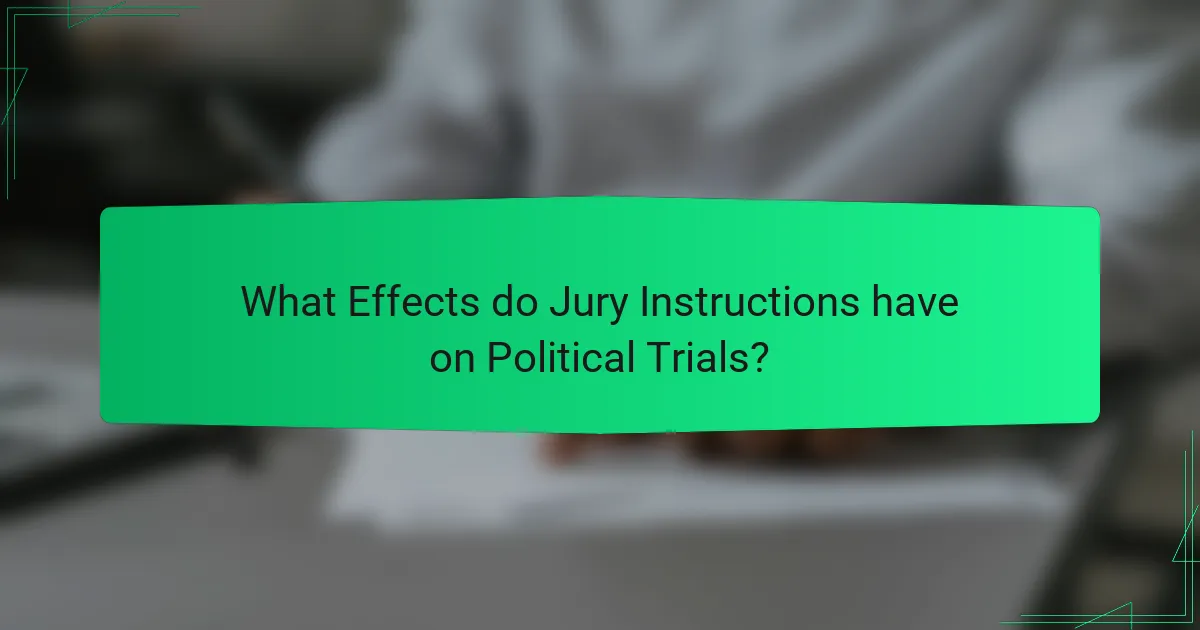
What Effects do Jury Instructions have on Political Trials?
Jury instructions significantly influence the outcomes of political trials. They guide jurors on how to interpret evidence and apply the law. Clear instructions can lead to informed decision-making. Conversely, vague or complex instructions may confuse jurors. This confusion can result in misinterpretation of critical evidence. Research indicates that juror comprehension directly impacts verdicts. For example, a study by the National Center for State Courts found that simplified jury instructions improved juror understanding in 75% of cases. Thus, effective jury instructions are crucial for fair political trial outcomes.
How do Jury Instructions shape the outcomes of political trials?
Jury instructions significantly shape the outcomes of political trials by guiding jurors on legal standards. These instructions clarify the applicable laws and the evidence required for a verdict. Clear jury instructions can lead to more informed decision-making. Conversely, ambiguous instructions may confuse jurors and result in inconsistent verdicts. Research indicates that well-structured jury instructions improve juror comprehension. For instance, a study by the American Bar Association found that jurors who received detailed instructions were more likely to reach a consensus. Additionally, jury instructions can influence the framing of evidence, impacting how jurors perceive the credibility of witnesses. Overall, the clarity and specificity of jury instructions play a crucial role in determining trial outcomes.
What evidence exists to support the influence of Jury Instructions?
Jury instructions significantly influence juror decision-making. Research shows that clear and concise jury instructions improve jurors’ understanding of legal standards. A study by the American Bar Association indicates that jurors often struggle with complex legal language. Simplified instructions lead to more accurate verdicts. Additionally, a meta-analysis published in the “Journal of Empirical Legal Studies” found that jurors are more likely to follow instructions that are straightforward. This demonstrates the critical role of jury instructions in ensuring fair trials.
How do Jury Instructions affect public perception of political trials?
Jury instructions significantly influence public perception of political trials. They guide jurors on interpreting evidence and applying the law. Clear instructions can lead to more informed and fair verdicts. When jurors understand their role, public trust in the judicial process increases. Conversely, vague or complex instructions may cause confusion. This confusion can result in perceptions of bias or unfairness. Studies show that juror comprehension affects public opinion on trial outcomes. For instance, research indicates that well-structured jury instructions correlate with higher satisfaction rates among the public. Therefore, the clarity of jury instructions is crucial in shaping perceptions of political trials.
What are Best Practices for Drafting Effective Jury Instructions?
Best practices for drafting effective jury instructions include clarity, simplicity, and relevance. Clear language ensures jurors understand the legal standards they must apply. Simple sentence structures help avoid confusion. Instructions should be directly relevant to the case at hand. This relevance reinforces the jurors’ focus on the specific facts they need to consider.
Using plain English helps jurors from diverse backgrounds comprehend complex legal concepts. Avoiding legal jargon enhances understanding. Providing examples can illustrate how the law applies to the facts. This practice aids jurors in making informed decisions.
Additionally, instructions should be concise to maintain jurors’ attention. Lengthy instructions may overwhelm jurors and lead to misunderstandings. Testing instructions with mock jurors can reveal areas of confusion. Feedback from this process can improve clarity and effectiveness.
Incorporating these best practices leads to more effective jury instructions, which ultimately supports fair trial outcomes.
How can clarity and comprehensibility be ensured in Jury Instructions?
Clarity and comprehensibility in jury instructions can be ensured through simple language and clear structure. Using plain language reduces confusion among jurors. Short sentences enhance readability and understanding. Logical organization helps jurors follow the instructions easily. Including examples can illustrate complex concepts effectively. Avoiding legal jargon minimizes misinterpretation. Providing summaries of key points reinforces comprehension. Research shows that jurors perform better when instructions are straightforward and well-organized. Studies indicate that clear jury instructions lead to more accurate verdicts.
What strategies can be employed to minimize challenges in political trials?
Strategies to minimize challenges in political trials include thorough jury selection, clear jury instructions, and effective communication. Thorough jury selection helps ensure impartial jurors. Impartial jurors are less likely to be influenced by external factors. Clear jury instructions provide jurors with a solid understanding of legal standards. This clarity reduces confusion during deliberations. Effective communication between legal teams and jurors fosters a better understanding of complex issues. Studies show that well-informed juries reach more equitable verdicts. Additionally, pre-trial motions can address potential challenges before they arise. These strategies collectively enhance the fairness of political trials.
The main entity of this article is jury instructions on evidence in political trials. The article emphasizes the critical role that clear and concise jury instructions play in guiding jurors’ understanding of legal standards and evidence evaluation. It discusses the significant impact of clarity on juror comprehension, decision-making, and trial outcomes, while also addressing the challenges and common issues faced in drafting effective jury instructions. Furthermore, the article explores how juror perceptions and biases influence the application of these instructions, ultimately affecting public trust in the judicial process.
